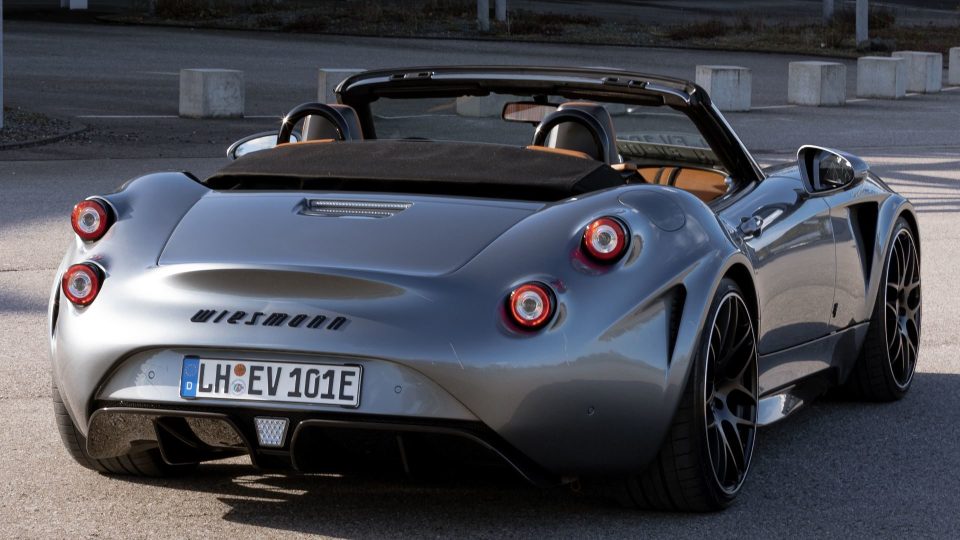
Imagine if TVR had upped sticks and moved from Lancashire to Münsterland, switched to brawny BMW engines and discovered Teutonic build quality. The result might look something like Wiesmann.
Founded in 1988, Wiesmann remains little known outside its native country. As charismatic new British CEO Roheen Berry explains: “We’ve been around for decades, but 90 percent of our cars were sold in Germany, so we never gained international recognition.” Now Wiesmann plans to go global.
Silent thunder

Leading the charge (yes, literally) is Project Thunderball – arguably the first dedicated electric sports car since the 2008 Tesla Roadster. The vehicle seen here is a prototype, but the finished product should reach a network of new boutique Wiesmann dealerships in early 2024.
Beyond that, Berry talks of a coupe version, a second sports car (probably also electric) and “maybe even an SUV”.
Unlike Wiesmanns of yore, Project Thunderball – an internal codename, but don’t be surprised if it sticks – doesn’t raid the BMW M parts store. Instead, its bespoke 92kWh battery comes from Munich-based Roding Group, which also helped engineer the Mars Rover.
With two electric motors driving the rear wheels, the headline numbers are impressive: 680hp, 0-62mph in 2.9 seconds and a 310-mile range.
Past masters

Before we unplug and play, I’m offered a chance to drive two of Wiesmann’s ‘heritage’ models. The GT MF5 coupe looks a bit like the bonkers Morgan Aeromax and has the thuggish 550hp twin-turbo V8 from a BMW X5 M.
But the smaller MF4-S roadster is more exciting still. Its 420hp naturally aspirated V8 hails from the E90 M3 and feels emancipated here, racing to the 8,400rpm limiter with an adrenalising metallic scream.
Frankly, no electric car offers such bombast and sense of occasion – and that includes Project Thunderball. Here, though, you get your kicks in different ways: savage and relentless acceleration, or the elastic effect of 811lb ft of torque, available the instant the twin axial-flux motors start spinning. Conversely, you might also enjoy the calm refinement, or the challenge of driving with one pedal to boost the batteries.
Energised electrons

This hard-worked development hack is some 200kg heavier than the production car (target kerb weight is 1,700kg), yet it changes direction with alertness and confidence-building poise. While many EVs feel desensitised, the Wiesmann offers real tactility and finesse.
It’s not perfect. I’d like more steering feedback and I’ll wager the current suspension setup, tuned on the smooth roads of North Rhine-Westphalia, would feel quite brittle on British tarmac. The soundtrack, a shrill whistle of energised electrons, is due some fine-tuning, too. I’m told Wiesmann is working on an “authentic” EV noise, augmented via the car’s speakers.
Elsewhere, Project Thunderball feels close to showroom-ready. Its carbon fibre panels fit together flawlessly, while its stance looks perfect on custom 21-inch wheels. The cabin is also far more accommodating than cramped Wiesmanns of old, combining hand-stitched leather and analogue dials with exposed carbon weave and a motorsport-style digital display.
Over-the-air updates are promised for the touchscreen media system, along with the option to swap the entire battery pack – for more power or a longer range – at a later date.
Bruce Wayne or Batman

As Berry reveals via the Wiesmann configurator, each Project Thunderball will also be a blank canvas, ready to be tailored to the owner’s taste. “It can be Bruce Wayne or Batman,” he says, showing me one virtual car inspired by luxury yachts, with red leather and mahogany trim, then another that resembles a pared-back road racer. The starting price is €300,000 (circa. £260,000), but rest assured you could spend a lot more.
If you want classic styling with the performance of a modern supercar, plus a side order of social acceptability, Project Thunderball (available to reserve now) should be worth waiting for. And that’s something we can’t, in good conscience, say for Elon Musk’s never-gonna-happen second Tesla Roadster – or indeed the ‘new’ TVR.
Tim Pitt writes for Motoring Research
PRICE: £260,000
POWER: 680hp
0-62MPH: 2.9sec
RANGE: 310 miles
KERB WEIGHT: 1,700kg
CO2 EMISSIONS: 0g/km